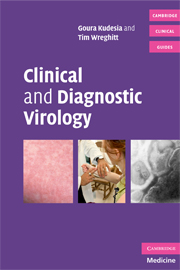Book contents
- Frontmatter
- Contents
- List of plates
- Preface
- Acknowledgements
- SECTION 1 INDIVIDUAL VIRUSES
- SECTION 2 OTHER RELATED AGENTS
- SECTION 3 CLINICAL SYNDROMES
- SECTION 4 DIAGNOSTIC TECHNIQUES
- 46 Sending specimens to the laboratory
- 47 Serological techniques
- 48 Virus detection
- 49 Molecular techniques
- SECTION 5 PATIENT MANAGEMENT
- Index
- Plate section
46 - Sending specimens to the laboratory
Published online by Cambridge University Press: 07 December 2009
- Frontmatter
- Contents
- List of plates
- Preface
- Acknowledgements
- SECTION 1 INDIVIDUAL VIRUSES
- SECTION 2 OTHER RELATED AGENTS
- SECTION 3 CLINICAL SYNDROMES
- SECTION 4 DIAGNOSTIC TECHNIQUES
- 46 Sending specimens to the laboratory
- 47 Serological techniques
- 48 Virus detection
- 49 Molecular techniques
- SECTION 5 PATIENT MANAGEMENT
- Index
- Plate section
Summary
Sending the correct specimens
It is important to establish which are the best specimens to send to the laboratory. Chapters in this book suggest which specimens are suitable for the diagnosis of different virus infections and clinical syndromes, but the reader is also advised to check with the local laboratory's user manual as not all assays are offered by all laboratories. It is important to consider when in the patient's clinical course specimens should be sent. There are a few simple rules of thumb.
Virus antibody is usually not present in serum reliably until about 10 days after the onset of symptoms.
For those viruses where specific IgM is not tested for, an acute sample taken as soon as possible after the onset of symptoms and a second specimen taken 10 days after the onset of symptoms allows for the detection of a specific antibody rise.
Viruses causing maculopapular rashes (e.g. measles virus) usually produce specific IgM antibody within a few days of the onset of the rash.
When diagnosing acute hepatitis, HBs Ag will be present at the onset of symptoms of HBV infection, but HAV IgM is not detectable until at least 5 days after the onset of symptoms.
In general, if you are sending specimens for virus culture, send them in virus transport medium. Do not send dry swabs for virus investigations – they will almost always be discarded.
In general, EDTA blood specimens are preferred for molecular diagnosis – but as with all test requests, check your local guidelines relating to which specimens to send when.
- Type
- Chapter
- Information
- Clinical and Diagnostic Virology , pp. 201 - 203Publisher: Cambridge University PressPrint publication year: 2009



